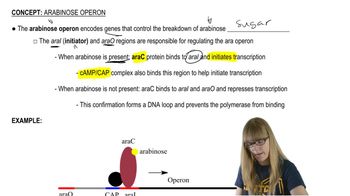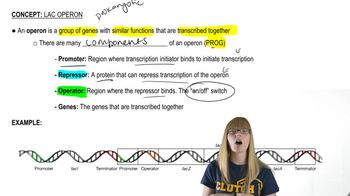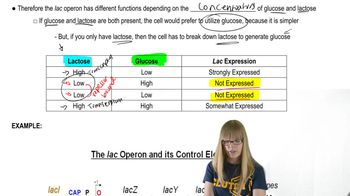Table of contents
- 1. Introduction to Genetics51m
- 2. Mendel's Laws of Inheritance3h 37m
- 3. Extensions to Mendelian Inheritance2h 41m
- 4. Genetic Mapping and Linkage2h 28m
- 5. Genetics of Bacteria and Viruses1h 21m
- 6. Chromosomal Variation1h 48m
- 7. DNA and Chromosome Structure56m
- 8. DNA Replication1h 10m
- 9. Mitosis and Meiosis1h 34m
- 10. Transcription1h 0m
- 11. Translation58m
- 12. Gene Regulation in Prokaryotes1h 19m
- 13. Gene Regulation in Eukaryotes44m
- 14. Genetic Control of Development44m
- 15. Genomes and Genomics1h 50m
- 16. Transposable Elements47m
- 17. Mutation, Repair, and Recombination1h 6m
- 18. Molecular Genetic Tools19m
- 19. Cancer Genetics29m
- 20. Quantitative Genetics1h 26m
- 21. Population Genetics50m
- 22. Evolutionary Genetics29m
12. Gene Regulation in Prokaryotes
Lac Operon
Problem 19e
Textbook Question
In a theoretical operon, genes A, B, C, and D represent the repressor gene, the promoter sequence, the operator gene, and the structural gene, but not necessarily in the order named. This operon is concerned with the metabolism of a theoretical molecule (tm). From the data provided in the accompanying table, first decide whether the operon is inducible or repressible. Then assign A, B, C, and D to the four parts of the operon. Explain your rationale. (AE=active enzyme; IE=inactive enzyme; NE=no enzyme.) Genotype tm Present tm Absent A⁺B⁺C⁺D⁺ AE NE A⁻B⁺C⁺D⁺ AE AE A⁺B⁻C⁺D⁺ NE NE A⁺B⁺C⁻D⁺ IE NE A⁺B⁺C⁺D⁻ AE AE A⁻B⁺C⁺D⁺/F'A⁺B⁺C⁺D⁺ AE AE A⁺B⁻C⁺D⁺/F'A⁺B⁺C⁺D⁺ AE NE A⁺B⁺C⁻D⁺/F'A⁺B⁺C⁺D⁺ AE+IE NE A⁺B⁺C⁺D⁻/F'A⁺B⁺C⁺D⁺ AE NE
 Verified step by step guidance
Verified step by step guidance1
Identify whether the operon is inducible or repressible by analyzing the enzyme activity in the presence and absence of tm. If the enzyme is active only in the presence of tm, it is inducible. If it is inactive in the presence of tm, it is repressible.
Examine the genotype A⁺B⁺C⁺D⁺: Active enzyme (AE) is produced when tm is present, and no enzyme (NE) is produced when tm is absent, suggesting an inducible operon.
Determine the role of each gene by analyzing the effects of mutations: A⁻B⁺C⁺D⁺ results in AE regardless of tm presence, indicating A is the repressor gene.
Analyze the genotype A⁺B⁻C⁺D⁺: NE is produced regardless of tm presence, suggesting B is the promoter sequence, as its mutation prevents transcription.
Consider the genotype A⁺B⁺C⁻D⁺: Inactive enzyme (IE) is produced when tm is present, indicating C is the operator gene, as its mutation affects enzyme activity. D is the structural gene, as its mutation (A⁺B⁺C⁺D⁻) results in AE regardless of tm presence.
Recommended similar problem, with video answer:
 Verified Solution
Verified SolutionThis video solution was recommended by our tutors as helpful for the problem above
Video duration:
1mPlay a video:
Was this helpful?
Key Concepts
Here are the essential concepts you must grasp in order to answer the question correctly.
Operon Structure
An operon is a cluster of genes under the control of a single promoter, which includes regulatory elements such as the repressor, operator, and structural genes. The repressor gene produces a protein that can bind to the operator, blocking transcription of the structural genes. Understanding the arrangement and function of these components is crucial for determining how the operon responds to the presence or absence of specific molecules.
Recommended video:
Guided course

Arabinose Operon
Inducible vs. Repressible Operons
Inducible operons are typically off and can be turned on in response to an inducer, while repressible operons are usually on and can be turned off by a corepressor. The distinction is important for understanding metabolic pathways; for example, the lac operon is inducible, while the trp operon is repressible. Analyzing the data provided helps in identifying the nature of the operon in question.
Recommended video:
Guided course

Induced Mutations
Enzyme Activity and Genotype
The activity of enzymes in response to different genotypes provides insight into the operon's functionality. The presence of active (AE), inactive (IE), or no enzyme (NE) under varying conditions indicates how the operon is regulated. By correlating the genotype with enzyme activity in the presence or absence of the theoretical molecule (tm), one can deduce the roles of genes A, B, C, and D in the operon.
Recommended video:
Guided course

Gamete Genotypes

 4:27m
4:27mWatch next
Master Lac Operon Overview with a bite sized video explanation from Kylia Goodner
Start learning



